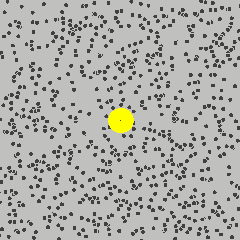 If temperatures are the same on all sides, the particle moves chaotically, as collisions of molecules are equally probable from all sides. When the temperature is higher on one side, collisions become more probable in that area, which makes the particle drift in the direction of lower temperatures. Credit: Sergei Belan
If temperatures are the same on all sides, the particle moves chaotically, as collisions of molecules are equally probable from all sides. When the temperature is higher on one side, collisions become more probable in that area, which makes the particle drift in the direction of lower temperatures. Credit: Sergei Belan
In a study published in the Physical Review Letters journal, researchers from Moscow Institute of Physics and Technology (MIPT) and the Weizmann Institute of Science (Israel) have shown the possibility of negative turbophoresis phenomenon. The movement of impure particles or dust in a turbulent flow, in an "impossible" direction is considered as the negative turbophoresis phenomenon.
The researchers observed how inertial particles behave when subjected to random forces in different types of environments. Dust particles in turbulent gas flows and Brownian particles in a thermostat are such systems.
Stokes' law of friction force influences a particle in turbulent flow. The resultant frictional force can be considered to be chaotic as the turbulent gas velocity changes chaotically. The heterogeneity of thermostat temperatures is considered to force particles to flow towards the direction of lower temperatures, and this is called as the thermophoresis phenomenon which happens quite commonly.
In oil lamps, the soot particles are pushed away from the flame due to the temperature gradient due to the thermophoresis effect. This causes blackening of oil lamp’s surfaces. In order to clean air from submicron-size particles, and also manipulate the nanoparticles, the thermophoresis effect is used. The turbophoresis effect, which is similar to the thermophoresis effect, occurs when inertial particles are present in turbulent flows. This also occurs when impure particles get deposited on tubes and when movement of dust takes place in the atmosphere.

A massive particle surrounded by particles of smaller mass. If temperatures are the same on all sides, the particle moves chaotically, as collisions of molecules are equally probable from all sides. When the temperature is higher on one side, collisions become more probable in that area, which makes the particle drift in the direction of lower temperatures.
Thermophoresis and turbophoresis are considered to inevitably cause accumulation of particles where low temperatures or low turbulence exist, respectively. And, particles in a turbulent flow were believed to always move towards the walls. However, the present study showed that for sufficiently heavy particles, negative turbophoresis occurred, which made the flow go towards greater intensity. Theoretically, the critical value of the inertia was determined, where the particle flow which was positive became negative.
This phenomenon is considered to be a novel type of phase transition. The inertial particle cloud can be localized or delocalized. When localized, it gets concentrated near the minimum of turbulence, and when delocalized it leaves this area.
The researchers are presently seeking ways to confirm the possibility of negative turbophoresis and the accuracy of the theoretical model in actual turbulent flows.
References